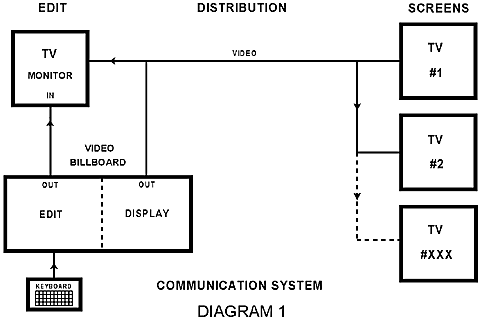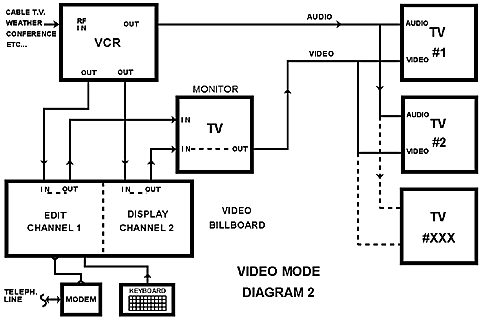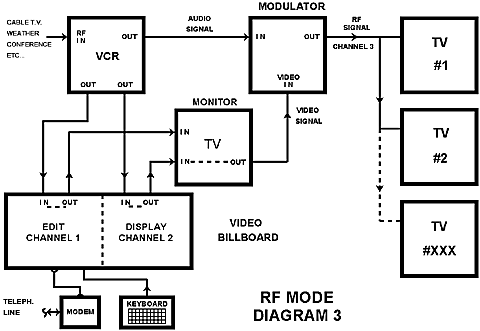The advent of world markets is pushing employee communication to play a more predominant role than ever in corporate success, and to call upon an array of tools to convey information to the people who are part of the organization. One of these tools is the video billboard. What is it, exactly, a substitute for other means of communication? What are the success factors and the pitfalls in its implementation? These are questions for which we will attempt to provide answers in this document.
Although the evolution of corporate economic activities has been documented over the last few centuries, the role and the form of communication can be traced for but a few decades. Not until the automation phase of the industrial age did the corporate world show interest in communication.
On the one hand, the growth of their production capacity forced corporations to develop increasingly more diverse and sophisticated advertising tools to publicize their products and to attract consumers. On the other hand, they soon realized that they could not increase their efficiency beyond a certain point without improving labor relations and the flow of information that they entail.
It was not until the 1950's, however, that the first foundations of employee communication were laid. It was indeed at that time, and in the wake of various American studies, that the first corporate magazines, employee newsletters and in-house bulletin boards made their debut.
Many new means of communication have since been created to support an adequate ascending, descending and lateral flow of information within organizations. "However, the practice of information is demanding: the more developed it becomes, the more we need it; the better delivered it is and the more polished and timely its distribution must be".3 Progress thus becomes unavoidable when engaging in this course of action.
The video billboard can be described as a communication system to distribute information via a network of television screens. To help you get a clearer picture of this system, think about the television screens that you consult in train stations and airports to check arrival and departure schedules. This is one application of the system, but used, in this instance, for external communication in public buildings.
Keeping this in mind, let's go back to describing the television screens that represent the last element and the most visible component of our communication system. To ensure easy access to the information circulated throughout companies, the screens are usually installed in collective areas bordering coffee machines, photocopiers, cafeterias and rest rooms. Some operations-related applications require that they be installed directly on the work site.
The information is transmitted to employees in an almost exclusively visual mode using texts that can be supplemented with illustrations or images. Depending upon circumstances, it is also possible to interrupt the communication of the various messages to present a live speech by the company president or a videotaped training session, or to retransmit a local television program.
Information editing and programming take place at the very core of the system using the video billboard equipment. The information is then forwarded to the television screens via a distribution network.
Diagram 1 below outlines the various components of this communication system.
We shall later come back to these components to review them in more detail.

The video billboard is not just a techno-fad like the latest video game or electronic gadget. More and more corporations are making use of this efficient technology and are discovering the numerous and unequalled advantages that it offers.
It would be wrong to pretend that organizations have very little information worth communicating, i.e., information that would not only interest all employees but that could also motivate them successfully.
In reality, there is always something interesting to say. Information is much more abundant than we might believe. Often, all that is missing is the means to tap it, to process it and to distribute it in a way that will make it attract attention.
One of the best ways to gather information is to involve all employees, starting with the president. The first goal is not to find the most sensational news but to find the kind of information that could be useful to a group of employees. A note of caution, however: we tend to reject information that we deem to be common knowledge or information that we believe will interest no one because we find it uninteresting.
When introducing a major change: "It is advisable to inform employees fully and firstly"3 to help them adapt to the change. Moreover: "Information is imperative simply because of the speed at which news travels"3 and because no room must be left for rumor. Also, companies may find themselves in critical situations resulting from pressure from competitive forces, tense labor relations or conflicts. These provide some "privileged opportunities to call upon information which, although it may not be the only element of the solution, plays a decisive role".3 In such circumstances, the video billboard proves itself to be an efficient communication tool because of its speed of intervention and its wide coverage.
In parallel to this, administrative reorganizations inevitably spell organizational changes that always come with a tremendous need for information, to reassure and to guide employees and to facilitate a smooth transition. Our experience as manufacturers indicates that many of the video billboards that we sell for employee communication purposes are meant to respond to such a need.
We propose a grid of information topics for your internal communications that will help you to establish and classify the subjects you might wish to broach. It will also be useful to prepare the title pages that your audience will use as reference.
Pursue with your own topics and their follow-up. This includes everything that brings an important change: a new structure, a new program, a new technology, a new process, an expansion, a move, the acquisition of a competing business or a fusion with another company.
Your products also constitute a good source of news. They provide an excuse to talk about changes in your market or modifications in your products, the introduction of new products or new sales programs, the launching of advertising or promotional campaigns, the selection of new distributors, and so on.
To conclude your news bulletin, you could announce the names of the clients and personalities visiting your premises during the current period.
Employees normally use the system to offer anniversary, wedding and birth wishes. They also announce intramural sports scores, social club activities, charity campaigns and their results, blood donor clinics, and so on.
Other companies use a second information channel to broadcast continuously the list of the various experts who are on call.
The success of a video billboard implementation for employee communication purposes in an organization depends on a series of interrelated factors of high complexity. While some of these factors may arise at random and uncontrollably, you can influence many of them to ensure success. To do this, you must make sure that:
In line with what we just stated, there are communication rules and practice-based principles that you must respect if you want to keep user attention and interest. We present them here as a series of pitfalls that you should avoid:
Check for yourself and you will discover the many ways in which video billboards are remarkable.
Communication is almost immediate. Once edited, information circulates at lightning speed, making video billboards an excellent means to convey urgent information to employees or to nip rumors in the bud.
Focusing exclusively on the essential elements of the information to be broadcasted means that the information remains precise and exact, leaving very little room for interpretation.
In no time at all, it becomes possible to reach all employees simultaneously, even if they are located in various rooms, in a multitude of buildings scattered over a large area or all over the world. Whatever work they have to accomplish, they can all be given access to a television screen.
Video billboards greatly facilitate access to information. "A strange but important consideration. It is an unfortunate reality that the more effort we have to exert to be informed, the less we will know"4. People always choose the easiest way. It is thus natural, whenever possible, to turn instinctively toward the television and its applications to obtain information. In fact: "It takes little effort to stop and watch a TV screen".4 Furthermore, as we are now living in a universe in which television is ever present, we show no reluctance to using it fully at work.
When businesses use video billboards to communicate, they can make substantial savings.
Furthermore, when comparing the cost of the information produced and broadcasted via video billboards to the cost of any other means of communication, the former is advantageous because it takes very little time to edit messages and very little money to broadcast them, costs being limited to the power used by the equipment. This is another net advantage to be added to our list.
More Advantages! . . . Here is a brief summary of other advantages provided by video billboards that we feel it is important to underscore:
What to Do with Existing Means of Communication?
We have seen that only video billboards have the capacity to broadcast instantly information that can be easily and simultaneously accessed by members of a large audience. No other means of communication, be it the board, billboard, departmental memo, employee newsletter, company magazine or teleconference, can claim equal status in this respect.
In other respects, it is a means of communication that allows the broadcasting of information under two forms. The information can be exceptional and timely, or it can be used to complement other means of communication. In the latter case, not only do you get the attention of your audience, but you also provide people with additional news or direct them toward another means of communication for more details.
"Ironically, none of these traditional pathways disappear once a message network is installed. They just settle into their most appropriate communication niche".4
Moreover: "To be heard, messages must be stated. This means that your message must appear in every communication support available to the organization. Communication tools only reach 30 percent of their target audience at a time".2
Video Billboards in Greater Detail
Now is a good time to come back to the description of this communication system that we put on hold earlier. At this point, we shall review the system in detail so that you may understand and appreciate its full range of possibilities.
This communication system features three types of equipment:
1. Editing and broadcasting equipment;
2. Distribution network;
3. Television screen network.
1. Editing and Broadcasting Equipment
The editing and broadcasting equipment is what we commonly call the video billboard. Two types are found on the market: computerized equipment that uses software programs designed for this application and dedicated equipment.
The software programs used in computerized equipment usually try to do everything and offer a vast array of options. This makes them at once very complex and difficult to use. Because they act as generalists, they fall short of the performance a specialist could reach and they quickly become obsolete as personal computer technology evolves.
Video billboards, on their part, are dedicated equipment: they are designed specifically to accomplish a very precise task, which is the editing and broadcasting of information.
To preserve user-friendliness, we suggest selecting a limited number of options that can easily meet all your creative needs and requirements. Text editing can be done in color on the various graphic backgrounds provided or on backgrounds specifically designed with the creative functions. Message storage capacity as well as font styles and special effects for laying out information pages may vary. More expensive equipment allows text editing on professional quality photographs retrieved from a file or through a video camera, and they offer the possibility of adding sound to the presentation.
The broadcasting function of the equipment calls upon everything that is needed to show messages cyclically. Messages are programmed according to a precise presentation schedule or calendar. Information updating may be done automatically without the need for any intervention. The same applies to remote message management, which is done via telephone lines.
It is also important to note that the equipment may provide several broadcasting channels to transmit various messages simultaneously and to control other sources of information such as: live broadcasting of a speech by the company president, or broadcasting of videotaped training sessions, external programs and teleconferences.
2. Distribution Network
The purpose of the distribution network is to link the video billboard to the television screens. Information travels almost exclusively via coaxial cables that can be directed to a particular screen or that can be used to link all screens within the network.
Although distribution usually occurs in video mode with separate audio and video cables, some installations use the RF mode. If this is the case, the signals are modulated on a radio frequency (the frequency of a television channel) before being transmitted to the screens via a cable. You will find diagrams 2 and 3 below for each of these modes of distribution.


Moreover, when information must be carried to remote locations, the transfer is done on the telephone via a modem or a satellite link. Upon reception, a video billboard relay takes charge of the information and forwards it to the distribution network.
When you plan your distribution network, you may find it advantageous to consider all eventual screen additions since completing all required wiring at once result in considerable cost savings.
3. Television Screen Network
Depending on planned applications, screens will be located in gathering areas near elevators, coffee machines, photocopiers, cafeterias, rest rooms or conference rooms and even occasionally in work areas. When deciding how many screens you will need, remember that the efficiency of your network will depend more on choosing appropriate locations for the screens than on choosing the right number of locations.
Two categories of screens are offered on the market. The first category comprises the conventional television screens that work in the RF broadcasting mode and that usually get modified to receive exclusively the channel used to broadcast information. The other category comprises the professional television screens commonly called television monitors that use direct audio and video connections.
Before closing this subject, it would be important to mention that the information broadcasted on these screens is first and foremost directed at employees and that it may not always, for that very reason, respond to the needs of visitors. You might wish to keep this in mind when preparing messages or selecting screen locations.
Implementing a video billboard requires a thorough planning and the making of many decisions at various levels in the organization. The following table outlines the main areas of decision:
This document introduced you to a communication tool and allowed you to weigh its efficiency through the appreciation of its advantages. In addition, it made you aware of the pitfalls that you must avoid and of the factors that will spell success in its implementation. You are now in a good position to recommend to your company the acquisition of a video billboard that will represent an excellent investment to boost your employees communications.
In the years to come, factors such as the development of the media, the democratization of culture, the opening of borders and the globalization of markets will continue to support the exponential growth of the information needs of organizations and their people. Stay alert and open to communication to make sure that changes occur smoothly and harmoniously. Remember also that you can always count on your video billboard to maintain over the years and at all times a forum where you can communicate with every employee in your organization.
© 1997-1999
Teledac Inc.
Site Map
Reach us
| ABOUT TELEDAC INC.: TELEDAC INC. is a manufacturer specialized in the development and manufacturing of a full range of video billboards in Montreal, Quebec. | |
| ABOUT THE AUTHOR: Michel Gauthier, B.Sc., M.B.A., a communication consultant for TELEDAC INC., has many years of experience in communication and marketing, an experience he acquired through teaching and working with various organizations. |
|
| This paper was presented at CEVEXPO97, in Montreal in November 1997 | |
© 1997-2002 Teledac Inc. Site Map Reach us www.teledac.com | |